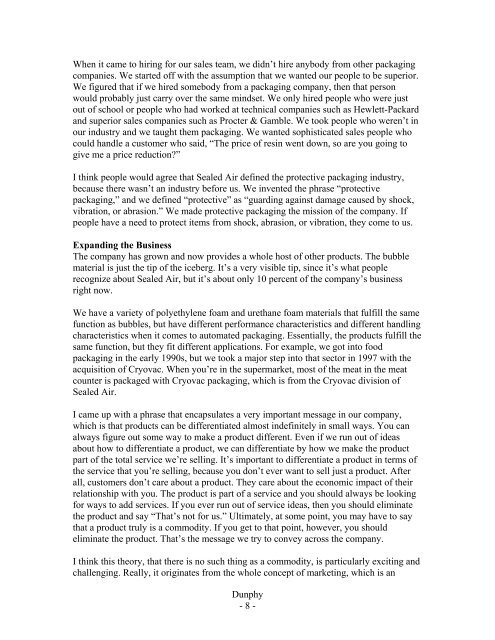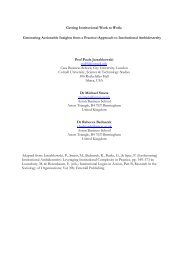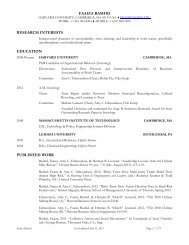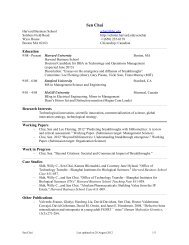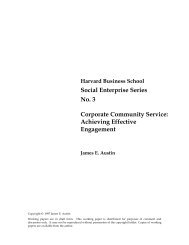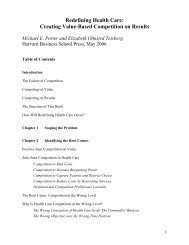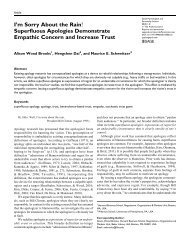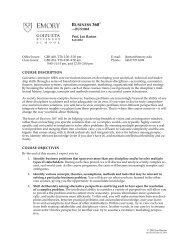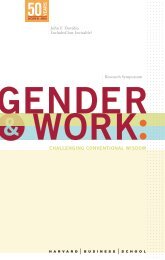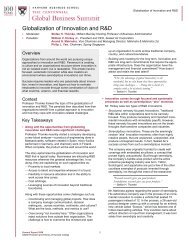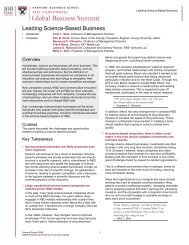TJ Dermot Dunphy - Harvard Business School
TJ Dermot Dunphy - Harvard Business School
TJ Dermot Dunphy - Harvard Business School
You also want an ePaper? Increase the reach of your titles
YUMPU automatically turns print PDFs into web optimized ePapers that Google loves.
When it came to hiring for our sales team, we didn’t hire anybody from other packaging<br />
companies. We started off with the assumption that we wanted our people to be superior.<br />
We figured that if we hired somebody from a packaging company, then that person<br />
would probably just carry over the same mindset. We only hired people who were just<br />
out of school or people who had worked at technical companies such as Hewlett-Packard<br />
and superior sales companies such as Procter & Gamble. We took people who weren’t in<br />
our industry and we taught them packaging. We wanted sophisticated sales people who<br />
could handle a customer who said, “The price of resin went down, so are you going to<br />
give me a price reduction?”<br />
I think people would agree that Sealed Air defined the protective packaging industry,<br />
because there wasn’t an industry before us. We invented the phrase “protective<br />
packaging,” and we defined “protective” as “guarding against damage caused by shock,<br />
vibration, or abrasion.” We made protective packaging the mission of the company. If<br />
people have a need to protect items from shock, abrasion, or vibration, they come to us.<br />
Expanding the <strong>Business</strong><br />
The company has grown and now provides a whole host of other products. The bubble<br />
material is just the tip of the iceberg. It’s a very visible tip, since it’s what people<br />
recognize about Sealed Air, but it’s about only 10 percent of the company’s business<br />
right now.<br />
We have a variety of polyethylene foam and urethane foam materials that fulfill the same<br />
function as bubbles, but have different performance characteristics and different handling<br />
characteristics when it comes to automated packaging. Essentially, the products fulfill the<br />
same function, but they fit different applications. For example, we got into food<br />
packaging in the early 1990s, but we took a major step into that sector in 1997 with the<br />
acquisition of Cryovac. When you’re in the supermarket, most of the meat in the meat<br />
counter is packaged with Cryovac packaging, which is from the Cryovac division of<br />
Sealed Air.<br />
I came up with a phrase that encapsulates a very important message in our company,<br />
which is that products can be differentiated almost indefinitely in small ways. You can<br />
always figure out some way to make a product different. Even if we run out of ideas<br />
about how to differentiate a product, we can differentiate by how we make the product<br />
part of the total service we’re selling. It’s important to differentiate a product in terms of<br />
the service that you’re selling, because you don’t ever want to sell just a product. After<br />
all, customers don’t care about a product. They care about the economic impact of their<br />
relationship with you. The product is part of a service and you should always be looking<br />
for ways to add services. If you ever run out of service ideas, then you should eliminate<br />
the product and say “That’s not for us.” Ultimately, at some point, you may have to say<br />
that a product truly is a commodity. If you get to that point, however, you should<br />
eliminate the product. That’s the message we try to convey across the company.<br />
I think this theory, that there is no such thing as a commodity, is particularly exciting and<br />
challenging. Really, it originates from the whole concept of marketing, which is an<br />
<strong>Dunphy</strong><br />
- 8 -


